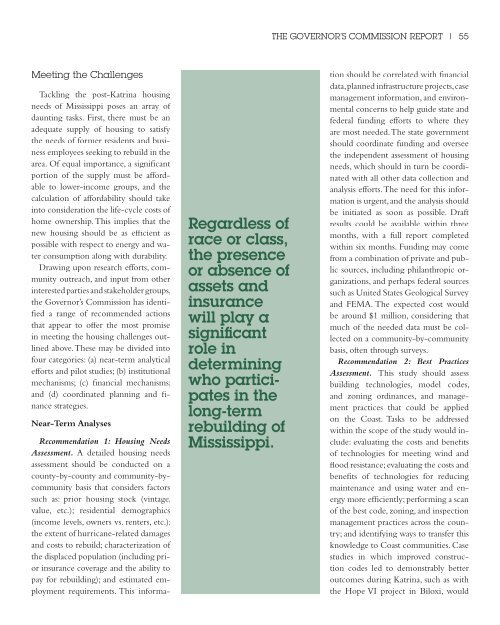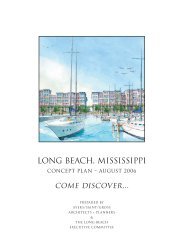Reports - Mississippi Renewal
Reports - Mississippi Renewal
Reports - Mississippi Renewal
- No tags were found...
You also want an ePaper? Increase the reach of your titles
YUMPU automatically turns print PDFs into web optimized ePapers that Google loves.
THE GOVERNOR’S COMMISSION REPORT | 55Meeting the ChallengesTackling the post-Katrina housingneeds of <strong>Mississippi</strong> poses an array ofdaunting tasks. First, there must be anadequate supply of housing to satisfythe needs of former residents and businessemployees seeking to rebuild in thearea. Of equal importance, a significantportion of the supply must be affordableto lower-income groups, and thecalculation of affordability should takeinto consideration the life-cycle costs ofhome ownership. This implies that thenew housing should be as efficient aspossible with respect to energy and waterconsumption along with durability.Drawing upon research efforts, communityoutreach, and input from otherinterested parties and stakeholder groups,the Governor’s Commission has identifieda range of recommended actionsthat appear to offer the most promisein meeting the housing challenges outlinedabove. These may be divided intofour categories: (a) near-term analyticalefforts and pilot studies; (b) institutionalmechanisms; (c) financial mechanisms;and (d) coordinated planning and financestrategies.Near-Term AnalysesRegardless ofrace or class,the presenceor absence ofassets andinsurancewill play asignificantrole indeterminingwho participatesin thelong-termrebuilding of<strong>Mississippi</strong>.Recommendation 1: Housing NeedsAssessment. A detailed housing needsassessment should be conducted on acounty-by-county and community-bycommunitybasis that considers factorssuch as: prior housing stock (vintage,value, etc.); residential demographics(income levels, owners vs. renters, etc.);the extent of hurricane-related damagesand costs to rebuild; characterization ofthe displaced population (including priorinsurance coverage and the ability topay for rebuilding); and estimated employmentrequirements. This informationshould be correlated with financialdata, planned infrastructure projects, casemanagement information, and environmentalconcerns to help guide state andfederal funding efforts to where theyare most needed. The state governmentshould coordinate funding and overseethe independent assessment of housingneeds, which should in turn be coordinatedwith all other data collection andanalysis efforts. The need for this informationis urgent, and the analysis shouldbe initiated as soon as possible. Draftresults could be available within threemonths, with a full report completedwithin six months. Funding may comefrom a combination of private and publicsources, including philanthropic organizations,and perhaps federal sourcessuch as United States Geological Surveyand FEMA. The expected cost wouldbe around $1 million, considering thatmuch of the needed data must be collectedon a community-by-communitybasis, often through surveys.Recommendation 2: Best PracticesAssessment. This study should assessbuilding technologies, model codes,and zoning ordinances, and managementpractices that could be appliedon the Coast. Tasks to be addressedwithin the scope of the study would include:evaluating the costs and benefitsof technologies for meeting wind andflood resistance; evaluating the costs andbenefits of technologies for reducingmaintenance and using water and energymore efficiently; performing a scanof the best code, zoning, and inspectionmanagement practices across the country;and identifying ways to transfer thisknowledge to Coast communities. Casestudies in which improved constructioncodes led to demonstrably betteroutcomes during Katrina, such as withthe Hope VI project in Biloxi, would




